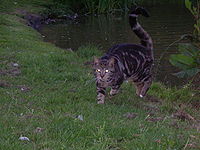Category 5 cable: Difference between revisions
No edit summary |
|||
| Line 38: | Line 38: | ||
[[de:Cat-5-Kabel]] |
[[de:Cat-5-Kabel]] |
||
[[sv:CAT5]] |
|||
Revision as of 19:20, 18 May 2006

Category 5 cable, commonly known as Cat 5, is an unshielded twisted pair cable type designed for high signal integrity. With the 2001 introduction of the TIA/EIA-568-B standard, the category 5 cabling specification was obsoleted and superseded by the category 5e specification.
The original specification for category 5 cable was defined in ANSI/TIA/EIA-568-A, with clarification in TSB-95. These documents specified performance characteristics and test requirements for frequencies of up to 100 MHz. Category 5 cable included four twisted pairs in a single cable jacket. It was most commonly used for 100Mbit/s networks, such as 100BASE-TX Ethernet, although IEEE 802.3ab defined standards for 1000BASE-T - gigabit Ethernet over category 5 cable. Cat 5 cable typically had three twists per inch of each twisted pair of 24 gauge copper wires within the cable. The twisting of the cable reduces electrical interference and crosstalk. Another important characteristic is that the wires are insulated with a plastic (FEP) that has low dispersion, that is, the dielectric constant of the plastic does not depend greatly on frequency. Special attention also has to be paid to minimizing impedance mismatches at connection points.
Usage and wiring methods
Cat 5 cables were often used in structured cabling for computer networks such as Fast Ethernet, although they were also used to carry many other signals such as basic voice services, token ring, and ATM (at up to 155 Mbit/s, over short distances).
Cat 5e cable is an enhanced version of Cat 5 that adds specifications for far-end crosstalk. Although 1000BASE-T was designed for use with Cat 5 cable, the tighter specifications associated with Cat 5e cable and connectors make it an excellent choice for use with 1000BASE-T. Despite the stricter performance specifications, Cat 5e cable does not enable longer cable distances for Ethernet networks: horizontal cables are still limited to a maximum of 90 m in length. Cat 5e cable performance characteristics and test methods are defined in TIA/EIA-568-B.2-2001.
Generally solid core cable is used for connecting between the wall socket and the socket in the patch panel whilst stranded cable is used for the patch leads between hub/switch and patch panel socket and between wall port and computer. Cable types, connector types and cabling topologies are defined by TIA/EIA-568-B. RJ-45 electrical connectors were nearly always used for connecting category 5 cable.
Other categories of network cables
- Cat 1: Currently unrecognized by TIA/EIA. Previously used for POTS telephone communications, ISDN and doorbell wiring.
- Cat 2: Currently unrecognized by TIA/EIA. Previously was frequently used on 4Mbit/s token ring networks.
- Cat 3: Current cable standard, used for data networks utilizing frequencies up to 16 MHz. Popular for 10 Mbit/s Ethernet networks.
- Cat 4: Currently unrecognized by TIA/EIA. Provided performance of up to 20 MHz, and was frequently used on 16Mbit/s token ring networks.
- Cat 6: Defined by the ANSI TIA/EIA 568B-2.1. It provides performance of up to 250 MHz, more than double category 5 and 5e.
- Cat 6a: Operates at frequencies up to 500MHz and provides up to 10Gbit/s
- Cat 7: Draft standard, proposed to include four individually-shielded pairs (ScTP) inside an overall shield. Designed for transmission at frequencies up to 650 MHz.
